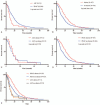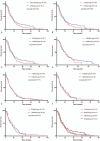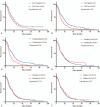ABO blood type, smoking status, other risk factors and prognosis of pancreatic ductal adenocarcinoma
- PMID: 32243360
- PMCID: PMC7220786
- DOI: 10.1097/MD.0000000000019413
ABO blood type, smoking status, other risk factors and prognosis of pancreatic ductal adenocarcinoma
Abstract
The aim of this observational study was to test whether ABO blood type was a prognostic factor for pancreatic ductal adenocarcinoma (PDAC) patients and whether other risk factors could influence pancreatic cancer patients' survival. This study included 610 patients who were diagnosed as pancreatic cancer and had undergone radical surgery. Patients' characteristics included age, gender, tumor stage, tumor grade, adenosquamous carcinoma (ASC) status, preoperative serum carbohydrate antigen 19-9 (CA19-9) levels, preoperative serum carcinoembryonic antigen (CEA) levels, ABO blood type, smoking status, and drinking status were analyzed in this study. Cox proportional hazards regression model and Kaplan-Meier method were used to evaluate the role of prognostic factors. For pancreatic cancer patients undergoing radical surgery, the overall survival was worse for ASC patients than PDAC patients (Log-rank = 11.315, P < .001). Compared with ASC patients (Log-rank < 0.001, P = .996), PDAC patients can benefit from chemotherapy (Log-rank = 17.665, P < .001). For PDAC patients, O blood type had better overall survival than non-O blood type (Log-rank = 4.153, P = .042). Moreover, the group with higher serum levels of CA19-9 had poor prognosis compared to another group with low serum CA19-9 (Log-rank = 4.122, P = .042). Higher CEA levels indicated poor prognosis (Log-rank = 13.618, P < .001). In conclusion, ASC status was associated with overall survival of pancreatic cancer patients and cannot benefit from postoperative chemotherapy. Non-O blood type was a prognostic factor for PDAC patients.
Conflict of interest statement
The authors have no conflicts of interest to disclose.
Figures



Similar articles
-
Preoperative CEA and CA 19-9 are prognostic markers for survival after curative resection for ductal adenocarcinoma of the pancreas - a retrospective tumor marker prognostic study.Int J Surg. 2013;11(10):1067-72. doi: 10.1016/j.ijsu.2013.10.005. Epub 2013 Oct 23. Int J Surg. 2013. PMID: 24161419
-
Serum high mobility group box-1 is a powerful diagnostic and prognostic biomarker for pancreatic ductal adenocarcinoma.Cancer Sci. 2012 Sep;103(9):1714-21. doi: 10.1111/j.1349-7006.2012.02358.x. Epub 2012 Jul 30. Cancer Sci. 2012. PMID: 22703527 Free PMC article.
-
Elevated serum CA19-9 level is a promising predictor for poor prognosis in patients with resectable pancreatic ductal adenocarcinoma: a pilot study.World J Surg Oncol. 2014 Jun 2;12:171. doi: 10.1186/1477-7819-12-171. World J Surg Oncol. 2014. PMID: 24890327 Free PMC article.
-
Total pancreatectomy for pancreatic ductal adenocarcinoma: review of the National Cancer Data Base.HPB (Oxford). 2016 Jan;18(1):21-8. doi: 10.1016/j.hpb.2015.07.009. Epub 2015 Dec 21. HPB (Oxford). 2016. PMID: 26776847 Free PMC article. Review.
-
Different clinical presentations of metachronous pulmonary metastases after resection of pancreatic ductal adenocarcinoma: Retrospective study and review of the literature.World J Gastroenterol. 2017 Sep 21;23(35):6420-6428. doi: 10.3748/wjg.v23.i35.6420. World J Gastroenterol. 2017. PMID: 29085191 Free PMC article. Review.
Cited by
-
Emerging Roles of N6-Methyladenosine Demethylases and Its Interaction with Environmental Toxicants in Digestive System Cancers.Cancer Manag Res. 2021 Sep 9;13:7101-7114. doi: 10.2147/CMAR.S328188. eCollection 2021. Cancer Manag Res. 2021. PMID: 34526822 Free PMC article. Review.
-
Association of ABO blood groups with ovarian reserve: a retrospective cohort study in Chinese Han women younger than 40 years with infertility.J Ovarian Res. 2022 Dec 20;15(1):132. doi: 10.1186/s13048-022-01075-0. J Ovarian Res. 2022. PMID: 36539903 Free PMC article.
-
The concomitant use of the renin-angiotensin system inhibitors and survival outcomes of patients with pancreatic adenocarcinoma: an analysis from a tertiary center.Ther Adv Med Oncol. 2024 May 6;16:17588359241247019. doi: 10.1177/17588359241247019. eCollection 2024. Ther Adv Med Oncol. 2024. PMID: 38716478 Free PMC article.
-
Childhood and adulthood passive and active smoking, and the ABO group as risk factors for pancreatic cancer in women.United European Gastroenterol J. 2024 May;12(4):440-450. doi: 10.1002/ueg2.12487. Epub 2023 Dec 8. United European Gastroenterol J. 2024. PMID: 38064161 Free PMC article.
-
Germline DNA damage repair gene mutations in pancreatic cancer patients with personal/family histories of pancreas/breast/ovarian/prostate cancer in a Japanese population.Ann Gastroenterol Surg. 2021 Jun 28;5(6):853-864. doi: 10.1002/ags3.12482. eCollection 2021 Nov. Ann Gastroenterol Surg. 2021. PMID: 34755017 Free PMC article.
References
-
- Siegel RL, Miller KD, Jemal A. Cancer statistics, 2018. CA Cancer J Clin 2018;68:7–30. - PubMed
-
- Rahib L, Smith BD, Aizenberg R, et al. Projecting cancer incidence and deaths to 2030: the unexpected burden of thyroid, liver, and pancreas cancers in the United States. Cancer Res 2014;74:2913–21. - PubMed
-
- Ducreux M, Cuhna AS, Caramella C, et al. Cancer of the pancreas: ESMO Clinical Practice Guidelines for diagnosis, treatment and follow-up. Ann Oncol 2015;26 Suppl 5:v56–68. - PubMed
-
- Kleeff J, Korc M, Apte M, et al. Pancreatic cancer. Nat Rev Dis Primers 2016;2:16022. - PubMed
Publication types
MeSH terms
Substances
LinkOut - more resources
Full Text Sources
Medical
Miscellaneous

